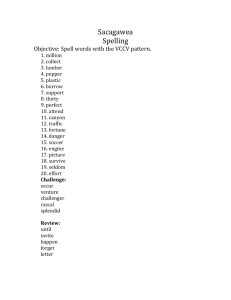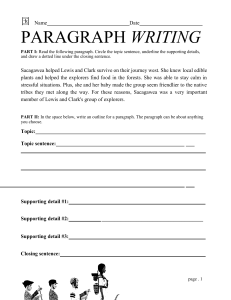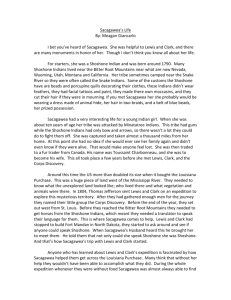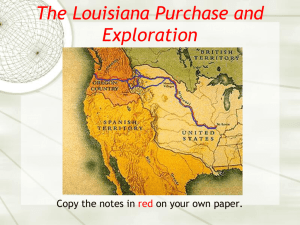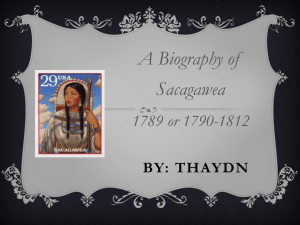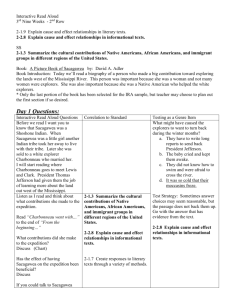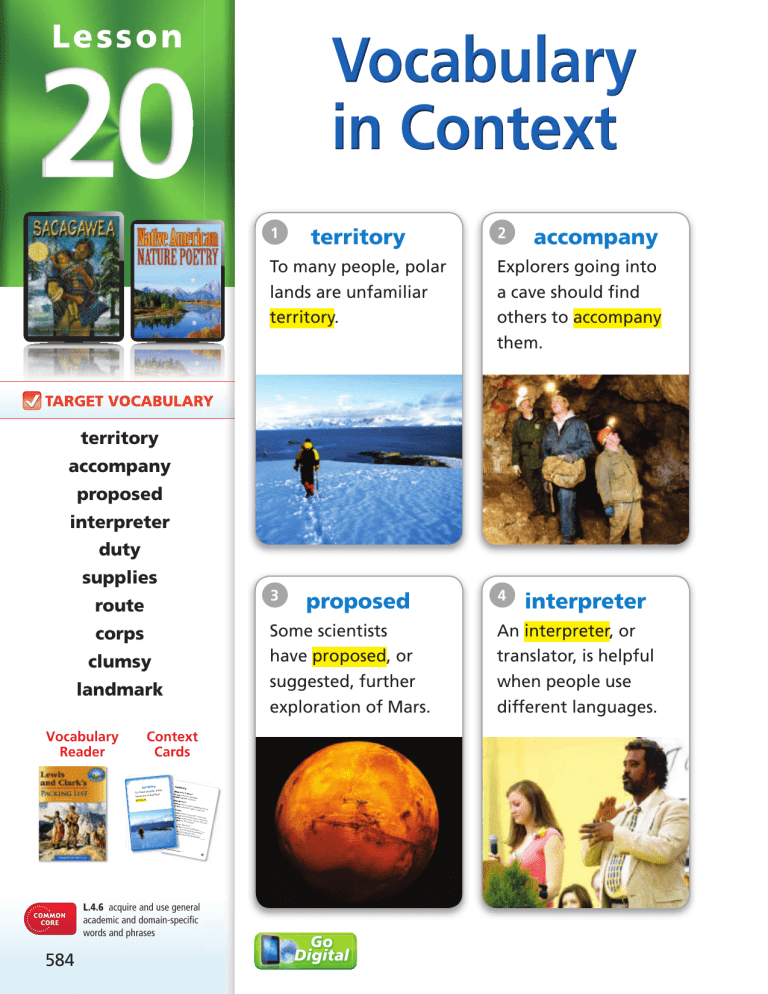
Lesson 1 territory 2 accompany To many people, polar lands are unfamiliar territory. Explorers going into a cave should find others to accompany them. 3 4 TARGET VOCABULARY territory accompany proposed interpreter duty supplies route proposed Some scientists have proposed, or suggested, further exploration of Mars. corps clumsy landmark Context Cards Vocabulary Reader 1 territo territory e, polar To many peopl iliar lands are unfam territory. ry What Does It Mea An area n? of land Spanish is cognate: a territory. territorio Think About It. Would you like never been expl to explore territory ored? that Why or Talk It Over. why not? has Read each sentence aloud to your to a part self. word ner the terri sentence Then read partner tory makes s in whic sense. agree h the Do on the answers? you and your The The state is on that shelf. we live in Did you was My dog your hom once Mexican thinks Lewis our back ework yeste . and Clark rday? yard is his explored . the Nort hwest . © Houghton 20.indd 385 4_246772RTXEAN_L Mifflin 4_246772R TXEAN_L2 PM Harcourt 1/15/09 4:59:16 Publishing Company. 0.indd All rights reserved. 191 386 1/15/09 L.4.6 acquire and use general academic and domain-specific words and phrases 584 4:59:24 PM Go Digital interpreter An interpreter, or translator, is helpful when people use different languages. Lesson 20 Study each Context Card. Use context clues to determine the meanings of these words. 5 duty 6 supplies Divers have a duty. They are required not to harm a marine area or its creatures. Hikers need to carry supplies, such as food and water. 8 9 corps On a research trip, every member of the corps, or team, must have valuable skills. clumsy A clumsy, or awkward, mistake can mean the loss of months of research. 7 route Backpackers should choose a safe route and stick to that path. 10 landmark Noting a landmark or other recognizable object makes the return trip easier. 585 Go Digital TARGET SKILL Main Ideas and Details As you read “Sacagawea,” look for the most important ideas the author presents. The most important ideas are called the main ideas. Also look for supporting details that tell more about the main ideas. Use a graphic organizer like the one below to help you see the relationship between main ideas and the details that support them. Then summarize the most important ideas. Supporting Detail Supporting Detail Main Idea Supporting Detail Supporting Detail TARGET STRATEGY Visualize You can visualize various stages of Sacagawea’s journey to help you identify the main ideas and supporting details at each part of their journey. Descriptive details in the text will help you form clear mental pictures of the people and places Sacagawea and her companions visited. RI.4.2 determine the main idea and explain how it is supported by details/summarize 586 PREVIEW THE TOPIC Native American History In the early 1800s, most of the American West was inhabited only by Native Americans. The Native Americans had deep knowledge of the lands where they lived. They were experts at locating food, making shelters, and finding their way in the wilderness. In 1804, Captains Meriwether Lewis and William Clark led an expedition to explore the western half of North America. Along the way, a young Shoshone woman named Sacagawea joined the expedition as a guide and translator. As you read “Sacagawea,” you’ll learn about the many contributions she made to the expedition. 587 MEET THE AUTHOR Lise Erdrich TARGET SKILL Main Ideas and Details Lise Erdrich is part Native American and a member of the Turtle Mountain band of Plains-Ojibway. She was inspired to become a writer by her grandfather, who was always writing or telling stories. Her sister Louise is also a writer of books for children and adults. Summarize a topic’s main ideas and supporting details. MEET THE ILLUSTRATOR Julie Buffalohead GENRE A biography tells about a person’s life and is written by another person. As you read, look for: information about why the person is important opinions and personal judgments based on facts events in sequence RI.4.2 determine the main idea and explain how it is supported by details/summarize; RI.4.3 explain events/procedures/ideas/ concepts in a text; RI.4.5 describe the overall structure of a text or part of a text 588 Go Digital Part Ponca Indian, Julie Buffalohead researched traditional Native American art while in college. She often depicts Native American legends and traditions in her painting. She sometimes uses her painting as a way to explore important topics, such as prejudices some people may have about Native Americans. by Lise Erdrich illustrated by Julie Buffalohead ESSENTIAL QUESTION How do people from different cultures contribute to American history? 589 It is the early 1800s. Teenaged Sacagawea (sak uh juh WEE uh) is a Shoshone (shoh SHOH nee) Indian living in the Knife River villages, in what is now North Dakota. When she was a child, Hidatsa (hee DAHT sah) Indians kidnapped her from her home in the Rocky Mountains. Since then, she has lived with them on the Great Plains, far from her family. Sacagawea has learned many things from the Hidatsa, including how to grow food. She is now married to a French Canadian fur trapper named Toussaint Charbonneau (too SAN shahr bohn OH). Meanwhile, Captains Meriwether Lewis and William Clark have been preparing for the Corps (kohr) of Discovery. They and their team, which includes a large, black Newfoundland dog, are about to start a long journey of exploration, all the way to the Pacific Ocean. On May 14, 1804, a crew of more than forty men set off against the Missouri River current in a keelboat and two large canoes called pirogues (pih ROHGZ). The Corps of Discovery was under way. The expedition arrived at the Knife River villages at the end of October. They were greeted with great excitement. Sacagawea heard tales of a gigantic black dog that traveled with the explorers. She heard that a fierce and awesome “white man” with black skin was among the crew. This was York, the slave of Captain Clark. The explorers built a fort and called it Fort Mandan. Then they settled in to spend the winter at the Knife River villages. Lewis and Clark soon learned they would need horses to cross the Rocky Mountains. The people of the villages told them they could get the horses from the Shoshone when the expedition reached the mountain passes. 590 The wily Charbonneau proposed that they hire him as a guide and interpreter. He did not speak Shoshone, but Sacagawea did. He told her they would be joining the Corps of Discovery in the spring. This was exciting news, but Sacagawea’s mind was on other matters. She was soon to become a mother. 591 In February, the time came for Sacagawea to have her baby. It was a long, difficult birth. Captain Lewis wanted to help her. He gave a crew member two rattlesnake rattles to crush and mix with water. Just a few minutes after drinking the mixture, Sacagawea gave birth to a baby boy. He was named Jean-Baptiste (zhawn bap TEEST) Charbonneau, but Captain Clark called him Pompy. Before long, the boy was known to everyone as Pomp. On April 7, 1805, the Corps of Discovery started west, struggling upstream on the mighty, muddy Missouri in two pirogues and six smaller canoes. Pomp was not yet two months old. As Sacagawea walked along the riverbank, she carried Pomp on her back, in a cradleboard or wrapped up snug in her shawl. Every member of the Corps of Discovery was hired for a special skill—hunter, blacksmith, woodsman, sailor. As an interpreter, Charbonneau was paid much more than the other crew members. But his skills as a sailor, guide, and outdoorsman were very poor. The only thing he did well was cook buffalo sausage. Sacagawea did what she could to help the expedition, even though she was paid nothing. As she walked along the shore with Captain Clark, Sacagawea looked for plants to keep the crew healthy. She gathered berries or dug for wild artichoke roots with her digging stick. Her Shoshone childhood had prepared her well for this journey. The Corps had been traveling less than two months when near disaster struck. Charbonneau was steering a boat through choppy waters when a sudden high wind tipped it sideways. He lost his wits and dropped the rudder while the boat filled with water. The expedition’s valuables were spilling overboard! Charbonneau was ordered to right the boat or be shot. 592 Sacagawea stayed calm and rescued the captains’ important things—journals, gunpowder, medicines, scientific instruments—every bundle she could reach. Without these supplies, the expedition could not have continued. A few days later, they came to a beautiful river. The grateful captains named it after Sacagawea. 593 By June, the corps was entering mountain country. Soon they could hear the distant roaring sound of the Great Falls of the Missouri. Captain Lewis thought the waterfall was the grandest sight he had ever seen. But there was no way to get past it by boat. It would take the corps nearly a month to get around the Great Falls and the four waterfalls they found just beyond it. The crew built creaky, clumsy wagons to carry their boats and supplies. Battered by hail, rain, and wind, the men dragged the wagons over sharp rocks and prickly pear cactus that punctured their moccasins. One day, a freak cloudburst caused a flash flood. Rocks, mud, and water came crashing down the canyon. Sacagawea held on to her son as tight as she could while Clark pushed and pulled them both to safety. Pomp’s cradleboard, clothes, and bedding were swept away by the rushing water, but all three were unharmed. By the middle of July, the corps was once again paddling up the Missouri. They reached a valley where three rivers came together, a place Sacagawea knew well. If she was upset to see it again, she did not show it. The captains learned how Sacagawea had been captured and her people killed. Sacagawea recognized a landmark that her people called the Beaver Head Mountain. She knew they must be nearing the summer camp of the Shoshone. ANALYZE THE TEXT Onomatopoeia In the first paragraph on this page is the word roaring. Roar is an example of onomatopoeia. That is, the sound and meaning of the word are similar. Find another example of onomatopoeia in the second paragraph on this page. 594 Nearly two weeks later, Sacagawea walked along the river, scanning the familiar territory. She spotted some men on horseback far ahead of them. Suddenly, Captain Clark saw Sacagawea dance up and down with happiness, sucking her fingers. He knew this sign meant that these were her people, the Shoshone. An excited crowd greeted the explorers at the Shoshone camp. Although years had passed since Sacagawea had been captured, a Shoshone woman recognized her. She rushed up to Sacagawea and threw her arms around her. 595 Lewis and Clark had discovered that their need for Shoshone horses was even greater than they thought. There was far more mountain country between the Missouri River and a water route to the Pacific than they expected. A grand council was called to discuss the matter. Sacagawea was to be one of the translators. Interpreting for the men at the chief’s council was a serious responsibility. Sacagawea wanted to do her best. But when she looked at the face of the Shoshone chief, she burst into tears. He was her brother, Cameahwait (kah mah WAY uht)! Sacagawea jumped up, threw her blanket over her brother, and wept. Cameahwait was moved, too. But the council had to continue. Though tears kept flooding back, Sacagawea kept to her duty until the council ended. 596 Sacagawea spent the last days of August with her people. The time passed too quickly. Before long, the expedition had to mount Shoshone horses and continue across the mountains, leaving their boats behind. The next part of their journey almost killed them. The mountain paths were narrow and dangerous, especially once it started to snow. Their feet froze, they didn’t have enough to eat, and the mountains seemed without end. Finally, the expedition emerged on the Pacific side of the Rockies. There Nez Perce (nehz purs) Indians helped them make new boats and agreed to keep the horses in case they returned that way in the spring. With great relief, the crew dropped their boats into the Clearwater River and let the current carry the expedition toward the ocean. At the beginning of November, the explorers noticed a sound that could only be the crashing of waves. They had finally reached the Pacific Ocean! The crew voted on where to make winter camp. Sacagawea was allowed to vote, too. She wanted to stay where she could find plenty of wapato roots for winter food. They set up camp not far from the ocean, in case a ship came to take them back home. But by now, people back east were sure the whole corps was long dead. No ship came for them. A cold rain soaked the crew as they cut logs and built Fort Clatsop. The hunters went to find game, while Sacagawea dug for wapato roots in the soggy ground. ANALYZE THE TEXT Text Structure Briefly summarize what has happened thus far in the text. Why did they set up a winter camp? How is the text organized? 597 Christmas Day was rainy and dreary, but the corps was determined to celebrate. The men fired a salute with their guns and sang. Sacagawea gave Captain Clark a fine gift of two dozen white weasel tails. In early January, Clark heard from some Indians that a whale had washed up onshore. He decided to go to the ocean to get blubber for the crew to eat. They were tired of their diet of lean spoiled meat and fish. 598 Sacagawea gathered up her courage and insisted that she be allowed to accompany Clark. She hadn’t traveled so far to leave without ever seeing the ocean! And she wanted to see that monstrous creature. The captains agreed to let her go. At last, Sacagawea saw the Pacific Ocean. She stood and stared at the great waters stretching endlessly in front of her. On the beach was the great skeleton of the whale. It was an amazing sight, nearly as long as twenty men lying end to end. The whale had been picked clean, but Clark was able to buy some blubber from the Indians to feed his men. 599 The crew stayed busy all winter, hunting, sewing moccasins, and making repairs on their equipment. Clark made maps, while Lewis worked on his report to President Jefferson. Sacagawea watched over Pomp as he began to walk. Captain Clark called him “my little dancing boy.” He had become very attached to Sacagawea and her son. When the time came, it would be hard for them to part. Spring arrived, and it was time to go back the way they had come. In late March, the Corps of Discovery headed up the Columbia River to retrieve their horses from the Nez Perce. 600 At a place called Travelers’ Rest, the expedition divided into two groups. Sacagawea would help guide Clark’s group south to the Yellowstone River. Lewis’s group would head northeast to explore the Marias River. At the end of July, Clark’s group came across an enormous rock tower on the banks of the Yellowstone. Clark named it Pompy’s Tower in honor of his beloved little friend. In the side of the rock, he carved: The two groups met up on August 12. Two days later, Sacagawea gazed once again upon the round earth lodges of the Knife River villages. She had been gone a year and four months. Lewis and Clark prepared to return to St. Louis. Before they left, Captain Clark came to talk to Sacagawea and Charbonneau. He offered to take Pomp back to St. Louis with him. He would see that the boy had a good education and would raise him as his own son. 601 602 Sacagawea knew that Captain Clark would take good care of her child. But he was not even two years old. She couldn’t let him go yet. Sacagawea and Charbonneau promised they would bring Pomp to visit Clark in a year or so. On August 17, 1806, Sacagawea watched as the Corps of Discovery set off again down the Missouri River. Her journey of exploration was over, but the Corps of Discovery still had hundreds of miles to go. ANALYZE THE TEXT Main Ideas and Details What is the main idea of the selection? What details does the author provide to support the main idea? 603 COMPREHENSION Dig Deeper How to Analyze the Text Use these pages to learn about Main Ideas and Details, Text Structure, and Onomatopoeia. Then read “Sacagawea” again to apply what you learned. Main Ideas and Details “Sacagawea” is a biography of a young Shoshone Indian named Sacagawea who helped captains Lewis and Clark explore the West. Throughout the selection, the author presents main ideas, or important ideas, about Sacagawea and her experience. The author explains these main ideas by giving details. Details include facts and examples that tell more about the main ideas. In “Sacagawea,” you learned that Sacagawea was a very important part of the Corps of Discovery. What details from the text support this main idea? Supporting Detail Supporting Detail Main Idea Supporting Detail Supporting Detail RI.4.2 determine the main idea and explain how it is supported by details/summarize; RI.4.3 explain events/procedures/ideas/concepts in a text; RI.4.5 describe the overall structure of a text or part of a text 604 Go Digital Text Structure Text structure is the way in which an author organizes ideas in a text or part of a text. Authors of historical texts usually explain events in the sequence in which they happened. For example, “Sacagawea” begins on the day the expedition set out in May of 1804. Next, the author describes their arrival at the Knife River villages at the end of October. Think about how each event fits into the text’s overall structure. Onomatopoeia Onomatopoeia is a literary device authors sometimes use to help readers imagine what something sounds like. When authors use onomatopoeia, they choose a word that sounds like what it means. For example, the word buzz sounds like a flying bee, and the word whoosh sounds like a waterfall. 605 RETURN TO THE ESSENTIAL QUESTION Turn Review the selection and to prepare to discuss Talk this question with a partner: How do people from different cultures contribute to American history? As you talk, take turns reviewing key ideas and explaining your own. Discuss rules, such as “Do not interrupt each other.” Classroom Conversation Continue your discussion of “Sacagawea” by explaining your answers to these questions: 1 Why do you think Sacagawea helped the Corps of Discovery? 2 What can you learn from Clark about how to be a good leader? Use ideas from the selection. 3 What do you think was Sacagawea’s most important contribution? Why? TEAM PLAYERS Discuss Success With a partner, discuss what made the Corps of Discovery team successful. Think about the challenges they faced and how they worked together to meet those challenges. How important was Sacagawea as a member of this team? Use text evidence from the selection to support your ideas. 606 WRITE ABOUT READING Response Suppose that you had been invited to go on Lewis and Clark’s expedition. Think about the qualities or skills that you would bring to the team. Also decide what you would have enjoyed most about the trip and what you would have found most difficult. Write two paragraphs explaining your ideas based on text evidence. Writing Tip To make your writing more interesting and precise, include colorful adjectives. End your paragraph with a strong conclusion that summarizes your skills. Go Digital RI.4.1 refer to details and examples when explaining what the text says explicitly and when drawing inferences; RI.4.2 determine the main idea and explain how it is supported by details/summarize; W.4.2d use precise language and domain-specific vocabulary; W.4.2e provide a concluding statement or section; W.4.9b apply grade 4 Reading standards to informational texts; SL.4.1.b follow rules for discussions; SL.4.1d review key ideas expressed and explain own ideas and understanding 607 ature and a person’s relationship to nature are two important themes in Native American poetry. A poem might include details that describe a common place, such as a forest with wind rustling through the trees. It might personify an object, giving human characteristics to it. Then again, a poem might tell what is important in life. N GENRE Poetry uses the sound and rhythm of words to suggest images and express feelings. TEXT FOCUS Free verse is poetry without a regular rhyme or regular rhythm. As you read “The Wind,” note how the poem does not have rhyme or rhythm like other poems you have read. How do the line breaks help create the poem’s feeling of wind movement? RL.4.5 explain major differences between poems, drama, and prose/refer to their structural elements; RL.4.10 read and comprehend literature 608 Go Digital Here am I Behold me It said as it rose, I am the moon Behold me. Teton Sioux The Wind At night, The wind keeps us awake, Rustling through the trees. We don’t know how we’ll get to sleep, Until we do— Dropping off as suddenly As the wind dying down. Crow Preserving Oral Traditions For centuries Native Americans passed their poems, songs, and stories orally from one generation to the next. People who did not speak Native American languages needed an interpreter to help them understand and write down these stories. By the late 1800s, people could use cylinder recorders to record and play sounds. Compared to today’s small electronic recorders, cylinder recorders were clumsy to use. Yet they preserved sounds exactly. In 1890 this recorder became important to scientist Jesse Fewkes, who was asked to accompany a corps of researchers to the southwestern United States. The cylinder recorder was among Fewkes’s supplies. He used it to record and preserve Native American oral stories. A cylinder recorder 609 You, whose day it is, Make it beautiful. Get out your rainbow colors, So it will be beautiful. Nootka I Think Over Again My Small Adventures I think over again my small adventures, My fears, Those small ones that seemed so big, For all the vital things I had to get and to reach; And yet there is only one great thing, The only thing, To live to see the great day that dawns And the light that fills the world. Anonymous (North American Indian; nineteenth century) Write a Poem About Beauty The poem “You, whose day it is” suggests that it is one’s duty to make the day beautiful. How would you make your day beautiful? Would you help someone you care about? Would you take a special route to visit a favorite landmark? Would you make a picture or admire a sunset? Have friends proposed ideas to you in the past? Write a poem that tells what you would do. 610 TEXT TO TEXT Compare Poems Sacagawea saw many wonderful natural sights during her journey. Which of the poems from “Native American Nature Poetry” might she have used to describe what she saw? Discuss with a partner which you think she would choose and why. Then write a poem about one of the sights Sacagawea saw. Use onomatopoeia, similes, and metaphors to help readers picture the scene. When you have finished, share your poem with a partner. Explain the similes and metaphors you have used. TEXT TO SELF Write a Journal Entry We know details of the Corps of Discovery expedition because Lewis and Clark kept journals. Recall an interesting trip you have taken. Write a journal entry about it. Explain why the trip was important to you. TEXT TO WORLD Research Native Americans Choose a Native American group that lived in your state in the past. Find at least three interesting facts about this group, and list them on a poster, along with drawings or photographs that help explain your facts. Go Digital W.4.7 conduct short research projects that build knowledge through investigation; W.4.10 write routinely over extended time frames and shorter time frames; L.4.3a choose words and phrases to convey ideas precisely; L.4.5a explain the meaning of similes and metaphors in context 611 L.4.2a use correct capitalization Go Digital What Is an Abbreviation? How Are Abbreviations Written? Some words have a shortened form called an abbreviation. An abbreviation stands for a whole word. Most abbreviations begin with a capital letter and end with a period. Use them only in special kinds of writing, such as addresses and lists. Some Common Abbreviations Mr. Jr. Mister Junior Capt. Dr. Addresses Rd. St. Road Street Ave. Avenue Blvd. Boulevard Months Feb. February Aug. Days Mon. Titles Measurements in. Monday inch/ inches Captain Doctor August Wed. Wednesday ft. Mrs. Ms. married woman any woman Ct. P.O. Court Post Office Oct. October Thurs. Thursday foot/feet mi. mile/miles Proofread the items below. On a sheet of paper, rewrite each group of words, using the correct abbreviations. Try This! 1 2 612 Andrew Perkins 438 Groat Avenue Grapevine, TEX 76051 5,280 feet = 1 mile 3 Thursday, Feb’y 8, 2010 4 Doctor Linda Martinez 4195 Buffalo Street Chadron, Nebraska 69337 Good writers use abbreviations only in special kinds of writing, such as addresses and lists. When you use abbreviations, make sure you write them correctly. Incorrect Abbreviations Doct. James Sekiguchi The Bradley Comp 127 Saratoga Boul. Montgomery, Ala. 36104 Weds, Sep. 18 4 ft, 7 in Correct Abbreviations Dr. James Sekiguchi The Bradley Co. 127 Saratoga Blvd. Montgomery, AL 36104 Wed., Sept. 18 4 ft., 7 in. Connect Grammar to Writing As you edit your personal narrative, correct any errors in capitalization or punctuation that you discover. If you used any abbreviations, make sure you used proper capitalization and punctuation. 613 W.4.3a orient the reader by establishing a situation and introducing a narrator or characters/organize an event sequence; W.4.3b use dialogue and description to develop experiences and events or show characters' responses; W.4.3c use transitional words and phrases to manage the sequence of events; W.4.3d use concrete words and phrases and sensory details; W.4.3e provide a conclusion Reading-Writing Workshop: Revise In “Sacagawea,” the author carefully chooses how to describe characters and events. Concrete words and phrases make the author’s ideas come alive. The author also uses transition words to connect events in the order they happen. When you review your personal narrative, add concrete words and transition words so your ideas are clearly communicated to your readers. Use the Writing Process Checklist below as you revise your writing. Steve drafted his narrative about a class adventure. When he revised it, he added concrete words and transition words. Ideas Go Digital Revised Draft Writing Process Checklist Prewrite Draft Revise Did I begin with an attention grabber? Did I organize events in a logical order? Did I use transition words to clearly show the order of events? Did I include detailed descriptions with concrete words and phrases? Does my ending show how the events worked out? Edit Publish and Share 614 When our teacher, Mrs. Kay, asked, “What community kind of project should our class do?” my shot hand went up. “Let’s go on the Walk to End Hunger,” I said. “We’ll raise money to help people. It will through our five be awesome to walk for miles.” hilly city Then First, Mrs. Kay listed our project ideas. We by ten votes voted. The walk won! Final Copy Our Walk to End Hunger by Steve Jones When our teacher, Mrs. Kay, asked, “What kind of community project should our class do?” my hand shot up. “Let’s go on the Walk to End Hunger,” I said. “We’ll raise money to help people. It will be awesome to walk for five miles through our hilly city.” First, Mrs. Kay listed our project ideas. Then we voted. The walk won by ten votes! People were really eager to help, including our principal, Mr. Desmond. “I’m so proud of you kids for doing this,” he said, and then he made a generous pledge. The day before the walk, our pledges totaled $425! The next day, May 6, we went by bus to where the walk would begin. There were colorful balloons, huge banners, and long tables with juice and granola bars. We walked for two hours. When we crossed the finish line, the crowd cheered wildly. I felt proud. Reading as a Writer How did Steve keep his narrative interesting? Where in your writing can you add descriptive details and concrete words and phrases? I added a conclusion that tells how the event turned out. I also made sure to use correct punctuation. 615
